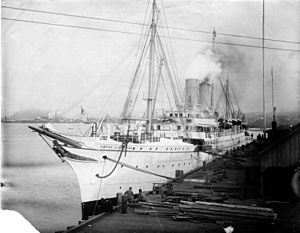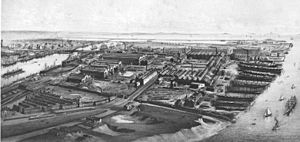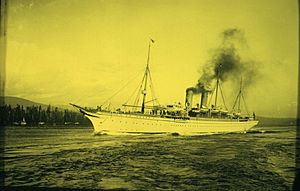RMS Empress of China (1890) facts for kids

C.P.R. steamer Empress of China at docks. Vancouver, BC, Canada.
|
|
Quick facts for kids History |
|
|---|---|
| Name | 1891-1913: Empress of China |
| Owner | 1891-1912: |
| Port of registry | 1891-1912: Canada |
| Builder | Naval Construction & Armament Co., Barrow |
| Laid down | 1890 |
| Launched | 25 March 1890 |
| Maiden voyage | 15 July 1891 |
| Fate | Scrapped in 1912, Yokohama |
| General characteristics | |
| Type | Ocean liner |
| Tonnage | 5,905 tons |
| Length | 455.7 ft |
| Beam | 51.2 ft |
| Propulsion | twin propellers |
| Speed | 16 knots |
| Capacity |
|
The RMS Empress of China was a large ocean liner built in England. It was made for Canadian Pacific Steamships (CP) between 1890 and 1891. This ship was the first of three CP vessels to be called Empress of China. It regularly sailed across the Pacific Ocean. Its route was between the west coast of Canada and places in Asia. The ship sailed until it hit an underwater reef and sank in Tokyo harbor in 1911.
Contents
What is a Royal Mail Ship?
In 1891, the Canadian Pacific Railway (CPR) and the British government made an important deal. They agreed on a contract for mail service between Britain and Hong Kong. This service would go through Canada.
To help with this, three special ocean liners were designed. Each of these ships was given a name that sounded important, like "Empress." The Empress of China and its two sister ships, RMS Empress of India and RMS Empress of Japan, were very important. They formed the main part of the CPR's fleet for the Pacific route. These ships served this route for the next 50 years.
The Ship's History
The Empress of China was built by a company called Naval Construction & Armament Co. This company is now part of Vickers Armstrongs. The ship was built in Barrow, England. Building started in 1890, and the ship was launched into the water on March 25, 1891.
The ship weighed 5,905 tons and was 455.6 feet long. Its width, called the beam, was 51.2 feet. The Empress of China was painted white and had a graceful front end. It had two yellow funnels with a black band at the top. It also had three light masts, like those on a schooner. The ship could travel at an average speed of 16 knots.
This Empress and its two sister ships were special. They were the first ships in the Pacific Ocean to have two propellers. These propellers were powered by special engines. The ship was designed to carry many people. It could hold 120 first-class passengers, 50 second-class passengers, and up to 600 steerage passengers.
Journeys and Famous Passengers
The Empress of China started its first journey on July 15, 1891. It left Liverpool and traveled through the Suez Canal to Hong Kong and Vancouver. After that first trip, it regularly sailed between Canada and the east coast of Asia. In the early days of wireless radio, the ship's special call sign was "MPG."
Sometimes, the ship had to stop for health checks. For example, if a passenger showed signs of a disease like smallpox, the ship would be held in port. This happened in Yokohama once, and the ship had to wait until everyone was safe. The ship's cargo areas were also regularly checked by port officials in places like Hong Kong, Yokohama, or Vancouver.
Some famous people traveled on the Empress of China. One was Archduke Franz Ferdinand of Austria. He boarded the ship in Yokohama on August 25, 1893, to sail across the Pacific to Vancouver. William Lyon Mackenzie King, who later became Canada's longest-serving Prime Minister, also visited the ship in Vancouver in 1901.
The Shipwreck
On July 27, 1911, the Empress of China was sailing in rough seas and thick fog. It was about 65 miles south of Tokyo Bay. The ship hit a hidden rock near the Nojimazaki Lighthouse. This happened while it was trying to go around the southern tip of the Bōsō Peninsula on its way to Yokohama.
This part of the bay is known for dangerous currents. Hidden rocks stretch about a mile from the coast there. Another ship had also sunk on the rocks in this area in 1907. Japanese navy ships, the Aso and Soya, came to help. They helped remove the mail, luggage, and passengers from the ship. Everyone was safely taken off, and no lives were lost.
About a year later, the Empress was pulled free from the rocks. In October 1912, it was towed to Yokohama. There, the ship was taken apart and scrapped.
Other Ships Named Empress of China
The name Empress of China was used for other ships too. After the first Empress of China was scrapped, Canadian Pacific bought two more ships. They were also confusingly named Empress of China for a short time.
- The first Empress of China was the 5,905-ton ship launched in 1891 from Barrow, England. This is the ship you just read about, which was wrecked in 1911 and scrapped in 1912.
- The second ship to be called Empress of China was the SS Empress of China. It was a much larger ship, weighing 16,992 tons. It was built in Germany in 1907. Canadian Pacific bought it in 1921 and renamed it Empress of China for a short time. Later that same year, it was renamed Empress of India. This ship was scrapped in 1929.
- The third ship to be called Empress of China was the SS Empress of China. This was an even bigger ship, 21,860 tons, built in Germany in 1913. Canadian Pacific bought it in 1921 and also renamed it Empress of China. In 1922, it was renamed Empress of Australia. This ship was scrapped in 1952.
See also
- CP Ships
- List of ocean liners
- List of ships in British Columbia
- Samuel Robinson, chief officer (1899)



